Beijing << bay jihng >> (pop. 18,300,000) is the capital and second largest city of China. Only Shanghai has more people. The city’s name is also spelled Peking << pee KIHNG >>. Beijing is famous for its beautiful palaces, temples, and huge stone walls and gates. Its art treasures and universities have long made the city China’s cultural center. The Chinese Communists, who came to power in 1949, also made Beijing a leading industrial and consumer city. Beijing lies on a plain in northern China, about 100 miles (160 kilometers) inland from the Bo Gulf.
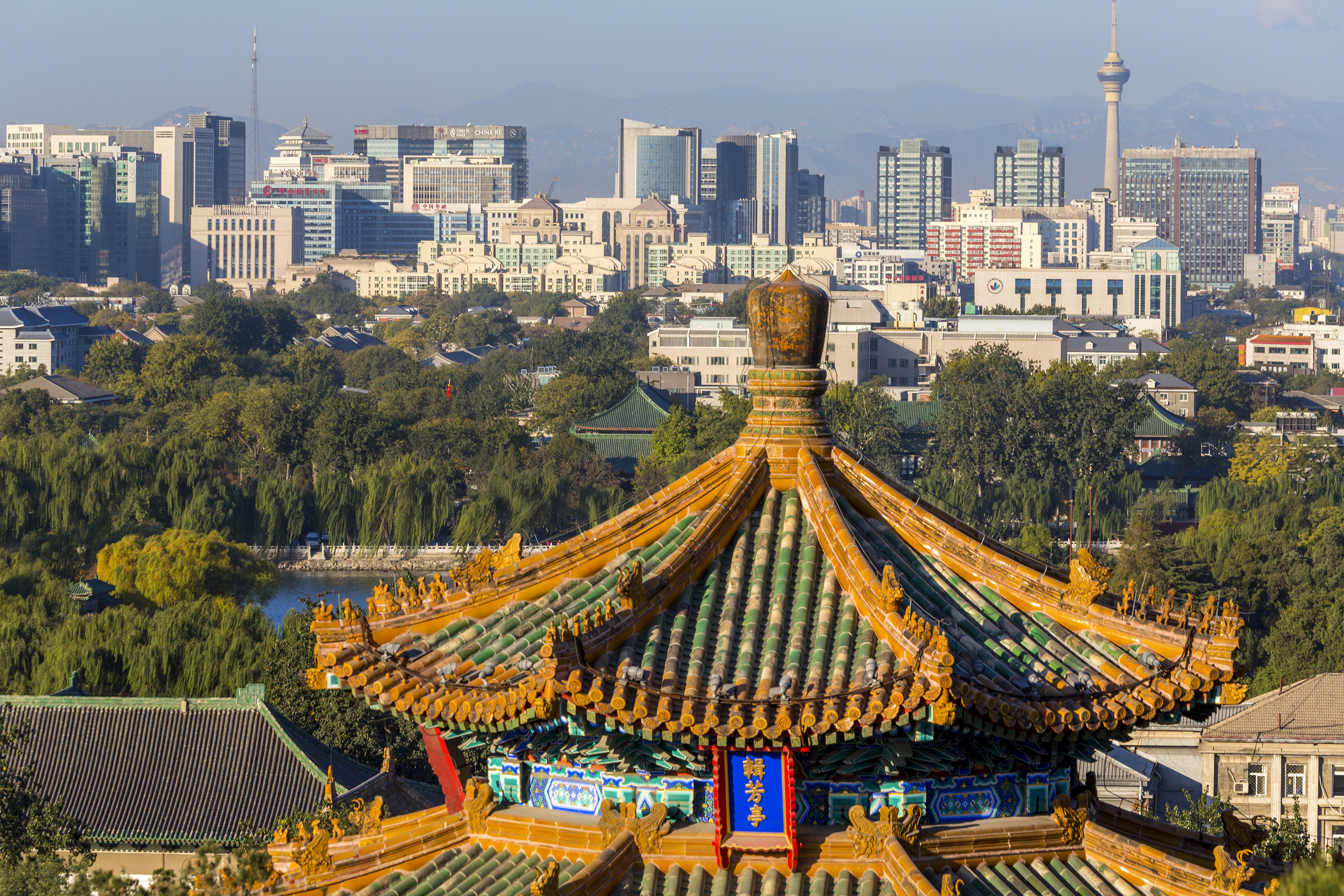
Beijing has been a center of government in China off and on for more than 2,000 years. Many rulers, including Mongol, Ming, and Manchu emperors, built palaces and temples in Beijing. Today, China’s central government leaders live and work in Beijing.
The city
of Beijing is part of the Beijing Municipality. This area consists of the central city, called the Old City; a series of suburbs; and farmland beyond.
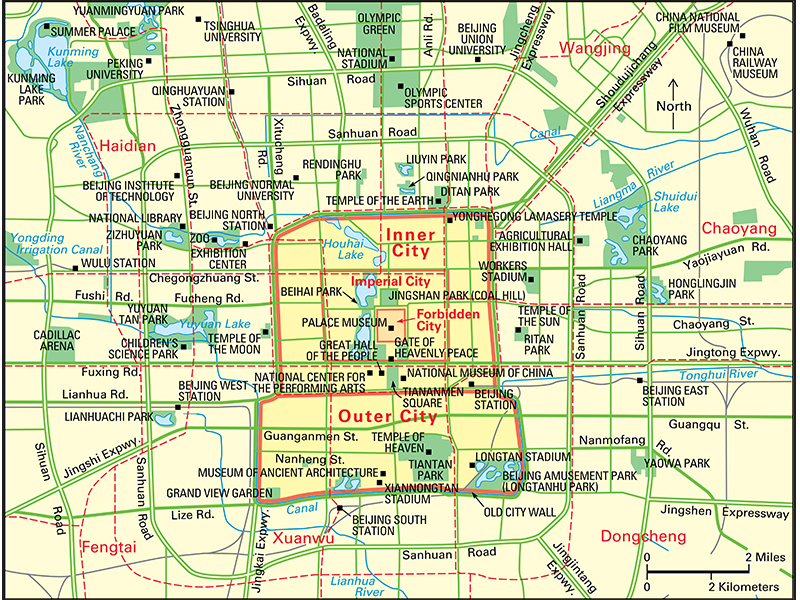
The Old City consists of two large, rectangular areas called the Inner City and the Outer City. Walls once surrounded both areas. Most of the walls have been torn down, but roads and subways follow the original boundaries of the Old City. Commercial areas, residential areas, and parks make up much of both the Inner City and the Outer City.
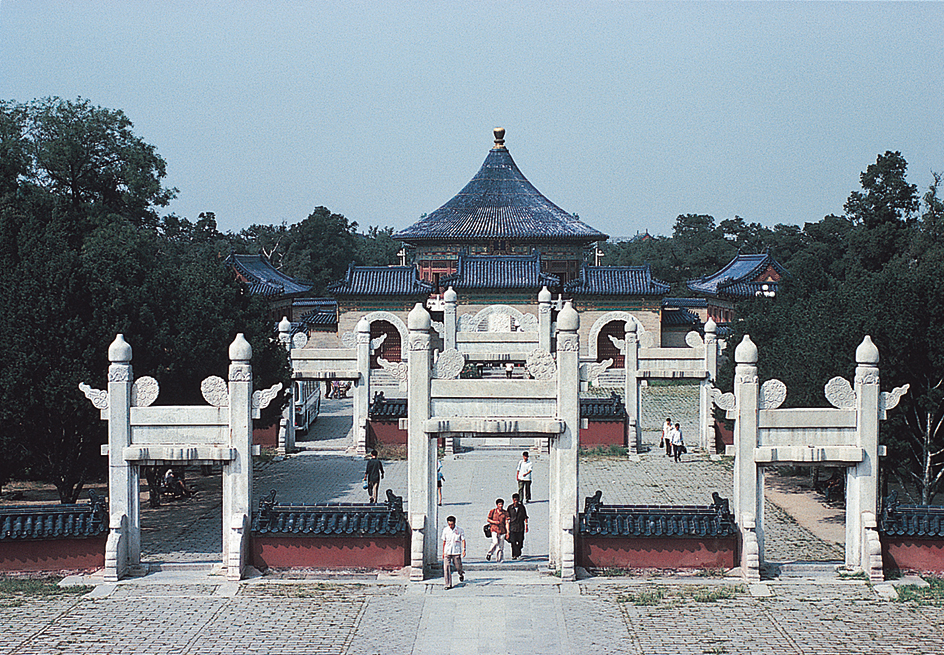
The Forbidden City and the Imperial City lie within the Inner City. The Forbidden City includes palaces of former Chinese emperors. It is so called because most common people were not allowed to enter it. The buildings in this part of Beijing are now preserved as a museum. The Imperial City surrounds the Forbidden City. It includes lakes, parks, and the residences of China’s Communist leaders. The Gate of Heavenly Peace (Tiananmen) stands at the southern edge of the Imperial City. This gate overlooks Tiananmen Square, where parades and fireworks displays take place on national holidays. The Great Hall of the People—China’s parliament building—and the National Museum of China border the square.
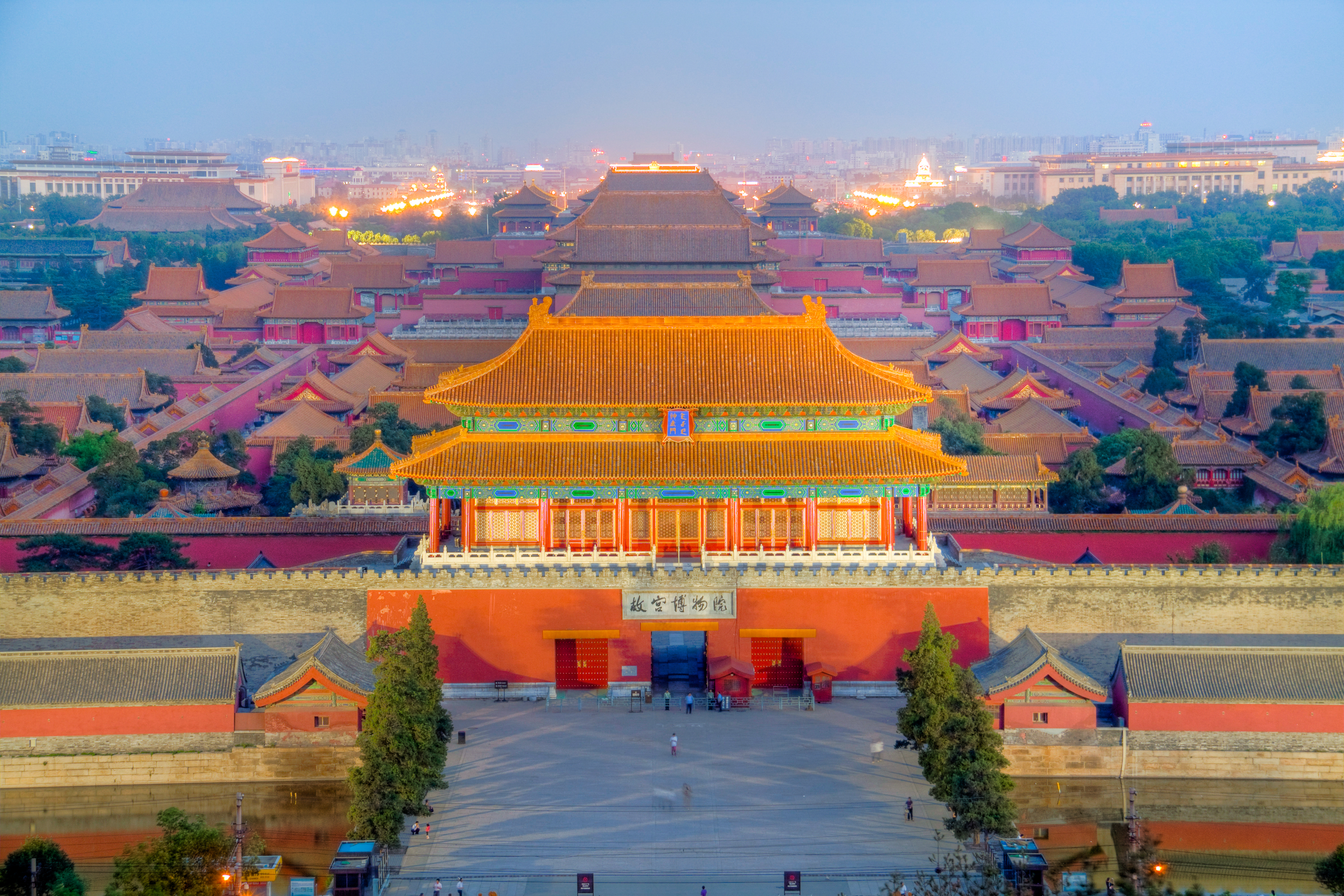
Commercial areas, residential areas, and parks make up much of Beijing’s Outer City. The Temple of Heaven stands at the southern end of the Outer City. Chinese emperors used to go there to pray for a good harvest. The Summer Palace, where many of China’s emperors lived during the summer, and tombs of Ming emperors lie northwest of the Old City. Peking and Tsinghua universities are in the northwest suburbs. Part of the Great Wall of China runs just north of Beijing.
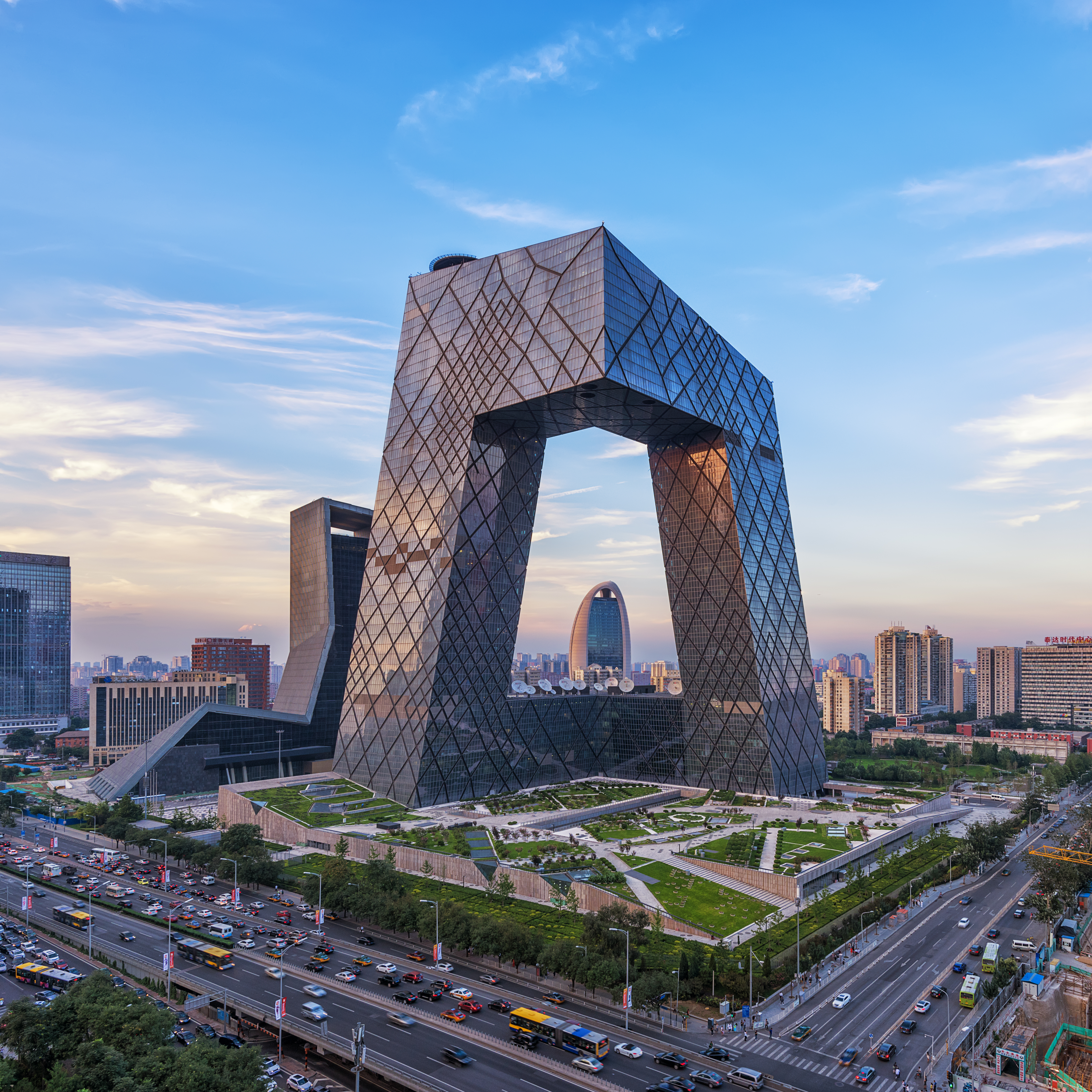
In Beijing, as in cities elsewhere, many of the houses are old. Many people in the Old City live in one-story houses that border narrow, tree-lined alleys called hutongs. The hutongs branch out from the main boulevards. Peddlers walk up and down the hutongs selling such foods as fish, noodle soup, and vegetables. However, the old houses and hutongs are rapidly disappearing to make way for modern buildings, apartment blocks, highways, and shopping centers. Suburbs to the north and northwest have many new apartment buildings. The government has built factories in the suburbs east and south of the Old City. Many old factories were moved elsewhere to lower the city’s level of air pollution.
Beijing is a major transportation hub and is connected to many cities in China and other countries by air, rail, and roads. A high-speed rail line links Beijing with the industrial center of Shanghai. Within the city, Beijing is served by a system of buses, beltways, and subways.
People.
Most of Beijing’s people belong to the Chinese nationality called Han, which is the largest ethnic group in the country (see China (Nationalities)). Some Hui (Chinese Muslims), Manchus, Mongols, and other ethnic minorities also live in the city. Most of the minority people in Beijing have adopted the customs and clothing of the Han people. Nearly all the people speak Northern Chinese (Mandarin), China’s official language.
Education and cultural life.
Nearly all children in Beijing go to elementary school. Most of them attend secondary school for at least three years. Beijing has numerous colleges, universities, and technical schools.

The National Library in Beijing is the largest in China. The city has many museums and theaters. Beijing opera and ballet companies perform throughout China.
Economy.
Beijing has a vibrant economy. High-tech industries and tourism play a major role. Other important industries include finance, banking, insurance, construction, and foreign trade.

There are many farms in Beijing outside the Old City. The farmers grow corn, cotton, fruits, vegetables, and wheat. They raise ducks, fish, and pigs. They also make light industrial products, such as furniture and handicrafts.
Government.
Beijing and its suburbs form one of four municipalities that are governed directly by the national government. These four metropolitan areas have a political status similar to that of a province. The other special municipalities are Chongqing, Shanghai, and Tianjin.
History.
Beijing was founded as a trading center, probably about 2000 B.C. It served as the capital of the small state of Yen, which existed from about 400 to 200 B.C. The Khitans invaded China from Manchuria and established the Liao dynasty in A.D. 907. They soon made Beijing one of their two national capitals. The Khitans called the city Yenjing, a name that is still sometimes used for Beijing.
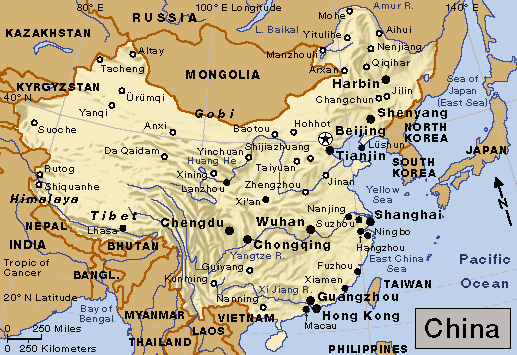
The Mongols conquered China in the late 1200’s and set up the Yuan dynasty. The Mongol leader Kublai Khan made Beijing his winter capital and began to build the city in its present form. Marco Polo, an Italian trader, visited Beijing in 1275 and praised its beauty.
The Ming rulers, who came to power in 1368, made Nanjing their capital. But they moved the capital to Beijing in the early 1400’s. They first called the city Beiping, meaning northern peace. They later changed its name to Beijing, which means northern capital. The Manchu rulers, who succeeded the Ming rulers in 1644, enlarged Beijing and added many palaces and temples.

In 1860, France and the United Kingdom forced China to allow foreign diplomats to live in Beijing. In 1900, a group of Chinese called Boxers tried to drive the foreigners out of China. They killed a German diplomat in Beijing and many Chinese Christians in northern China. An army of eight nations—Austria-Hungary, France, Germany, Italy, Japan, Russia, the United Kingdom, and the United States—then attacked Beijing and destroyed many of the city’s treasures (see Boxer Rebellion). After the last Manchu emperor fell from power in 1912, a series of local rulers called warlords controlled Beijing, the capital of the new Republic of China.
Japan gained control of treaty ports in Shandong Province early in 1919. Students in Beijing staged a protest against Japan’s influence in China on May 4, 1919. They organized the May Fourth Movement, a drive aimed at restoring China’s pride and strength.
The Chinese Nationalist Party captured Beijing from the warlords in 1928. Its leader, Chiang Kai-shek, made Nanjing China’s capital and changed Beijing’s name back to Beiping. In 1937, the Japanese defeated the Chinese at the Marco Polo Bridge south of Beijing and seized the city. Nationalist troops recaptured Beijing in 1945, but it fell to the Chinese Communists in 1949.
On Oct. 1, 1949, speaking at the Gate of Heavenly Peace, Mao Zedong declared the establishment of the People’s Republic of China. The Communists renamed the city Beijing and made it China’s capital. They built new buildings in Beijing, developed various industries in the suburbs, and organized the farmland into people’s communes (collectively owned farm communities). See Mao Zedong.
Mao closed Beijing’s schools in 1966, marking the beginning of the Cultural Revolution. He organized the students into units of “Red Guards,” which worked to rid the Communist Party of opponents of Mao’s policies. The students helped drive Beijing’s civilian government from power, and control passed to a revolutionary committee made up of army and civilian leaders loyal to Mao. In 1979, three years after the death of Mao, Beijing was ruled again by a civilian government.
In 1976, a major earthquake struck the Beijing area. It was centered in the nearby city of Tangshan. The earthquake caused at least 240,000 deaths, and some estimates run as high as 655,000. It also caused widespread property damage in the area.
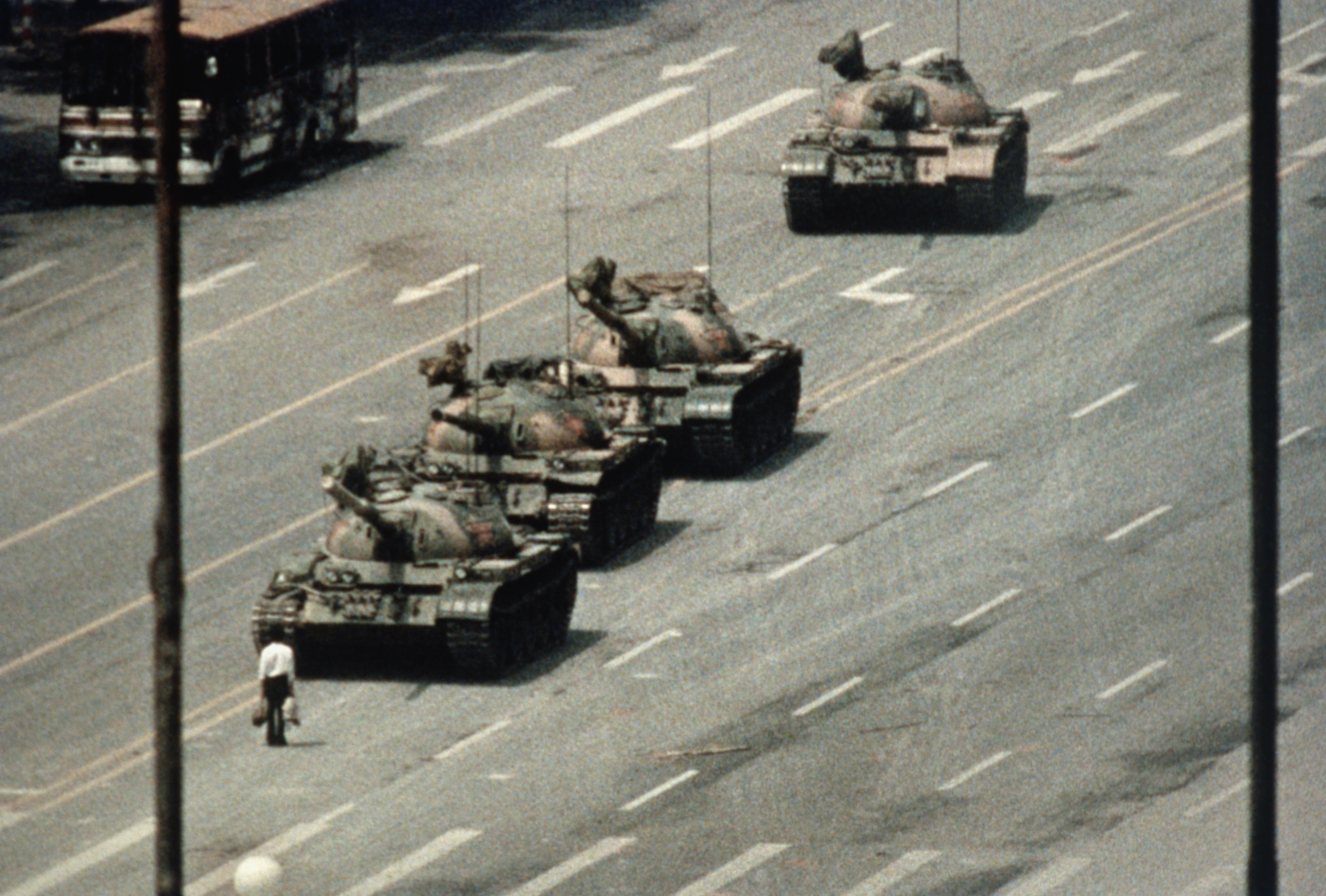
Beijing was the site of the 2008 Summer Olympic Games. The city undertook a number of major construction projects to improve its services and facilities for the games. These included the National Center for the Performing Arts, a massive performance hall; Terminal 3 at Beijing Capital International Airport; and Beijing National Stadium, nicknamed “the Bird’s Nest,” which hosted the Olympics’ opening and closing ceremonies, as well as many of its competitions. The city acquired a second international airport in 2019, with the opening of the huge Daxing International Airport. In 2022, Beijing hosted the Winter Olympic Games, making it the first city ever to host both a Summer and a Winter Olympics.

See also China; Forbidden City; Tiananmen Square protests of 1989; Tianjin.
